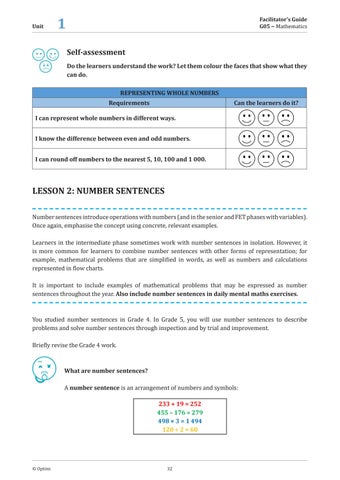Unit
1
Facilitator’s Guide G05 ~ Mathematics
Self-assessment Do the learners understand the work? Let them colour the faces that show what they can do. REPRESENTING WHOLE NUMBERS Requirements
Can the learners do it?
I can represent whole numbers in different ways. I know the difference between even and odd numbers. I can round off numbers to the nearest 5, 10, 100 and 1 000.
LESSON 2: NUMBER SENTENCES Number sentences introduce operations with numbers (and in the senior and FET phases with variables). Once again, emphasise the concept using concrete, relevant examples. Learners in the intermediate phase sometimes work with number sentences in isolation. However, it is more common for learners to combine number sentences with other forms of representation; for example, mathematical problems that are simplified in words, as well as numbers and calculations represented in flow charts. It is important to include examples of mathematical problems that may be expressed as number sentences throughout the year. Also include number sentences in daily mental maths exercises.
You studied number sentences in Grade 4. In Grade 5, you will use number sentences to describe problems and solve number sentences through inspection and by trial and improvement. Briefly revise the Grade 4 work.
What are number sentences? A number sentence is an arrangement of numbers and symbols: 233 + 19 = 252 455 – 176 = 279 498 × 3 = 1 494 120 ÷ 2 = 60
© Optimi
32



